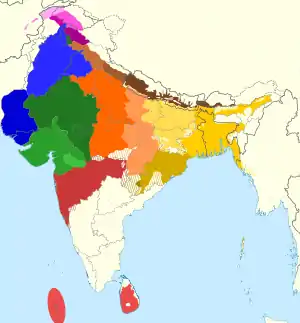Eastern Indo-Aryan languages
The Eastern Indo-Aryan languages, also known as Māgadhan languages, are spoken throughout the eastern subcontinent, including Bihar, Jharkhand, Bengal, Odisha, and Assam; alongside other regions surrounding the northwestern Himalayan corridor. Bengali is official language of Bangladesh and the state of West Bengal, while Assamese and Odia are the official languages of Assam and Odisha, respectively. The Eastern Indo-Aryan languages descend from Magadhan Apabhraṃśa[1] and ultimately from Magadhi Prakrit.[2][3][1]
| Eastern Indo-Aryan | |
|---|---|
| Magadhan | |
| Geographic distribution | Eastern India, Bangladesh, southern Nepal |
| Linguistic classification | Indo-European
|
Early forms | |
| Subdivisions | |
| Glottolog | indo1323 (Indo-Aryan Eastern zone) biha1245 (Bihari) |

Major Indo-Aryan languages of South Asia; Eastern Indo-Aryan languages in shades of yellow
Classification
The Eastern Indo-Aryan languages fall into four groups:
- Tharu, Majhi, Musasa
- Kuswaric: Danwar, Bote-Darai, Kumhali
- Bhojpuri, Caribbean Hindustani, Sadri (Nagpuri)
- Magahi, Khortha, Kurmali (Panchpargania)
- Maithili, Angkika, Bajjika
- Bengali-Gauda: Bengali (Bangali, Rarhi, Varendri, Sundarbani, Manbhumi, Dhakaiya Kutti, Dobhashi), Bishnupriya Manipuri, Sylheti, Hajong, Chittagonian, Chakma, Tanchangya, Rohingya
- Kamarupic: Assamese (Kamrupi, Goalpariya), Rangpuri, Surjapuri, Rajbanshi
- Baleswari, Garhjati (Northwestern Odia), Central Odia, Ganjami, Sambalpuri, Desia, Bodo Parja, Reli, Kupia
Features
Grammatical features of the Eastern Indo-Aryan languages:[4]
| Case | Bengali | Assamese | Odia | Rajbangshi | Surjapuri | Maithili | Bhojpuri | Tharu |
|---|---|---|---|---|---|---|---|---|
| Instrumental | -t̪e, -ke d̪ie | -e, -er-e, di, -e-di | -e, -re, -d̪ei | -d̪i | sɛ | -e,e˜, sə˜, d̪ea | le, leka | |
| Dative | -ke, -[e]re | -k, -ɒk | -ku | -k, -ɔk | -k, -ɔk | -ke˜ | -ke | -hənə |
| Ablative | -t̪ʰeke | pɒra | -u, -ru, ʈʰaru, ʈʰiru | hat̪ɛ, t̪ʰaki | sɛ | sə˜, -k karəne | se | |
| Genitive | -r, -er | -r, -ɒr | -rɔ | -r, -ɛr | -r, -ɛr | -ker (-k) | -kæ | -ək |
| Locative | -e, -t̪e | -t, -ɒt | -re | -t̪, -ɔt̪ | -t̪, -ɔt̪ | e, me, -hi, -tə | -mə |
References
- Ray, Tapas S. (2007). "Chapter Eleven: "Oriya". In Jain, Danesh; Cardona, George. The Indo-Aryan Languages. Routledge. p. 445. ISBN 978-1-135-79711-9.
- Cardona, George; Jain, Dhanesh, eds. (2003), "The historical context and development of Indo-Aryan", The Indo-Aryan Languages, Routledge language family series, London: Routledge, pp. 46–66, ISBN 0-7007-1130-9
- South Asian folklore: an encyclopedia : Afghanistan, Bangladesh, India, By Peter J. Claus, Sarah Diamond, Margaret Ann Mills, Routledge, 2003, p. 203
- (Toulmin 2006:148)
External links
- A Comparative dictionary of the Bihārī language, Volume 1 By August Friedrich Rudolf Hoernle, Sir George Abraham Grierson (1885)
- Toulmin, Mathew W S (2006). Reconstructing linguistic history in a dialect continuum: The Kamta, Rajbanshi, and Northern Deshi Bangla subgroup of Indo-Aryan (PhD). The Australian National University.
This article is issued from Wikipedia. The text is licensed under Creative Commons - Attribution - Sharealike. Additional terms may apply for the media files.